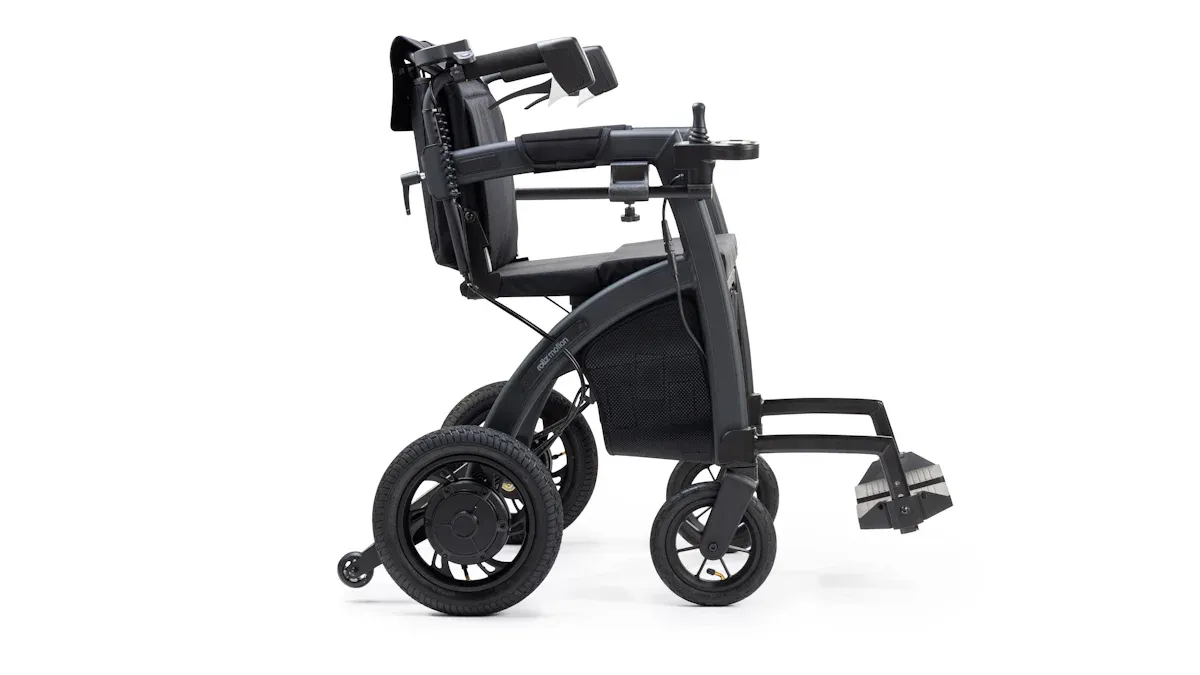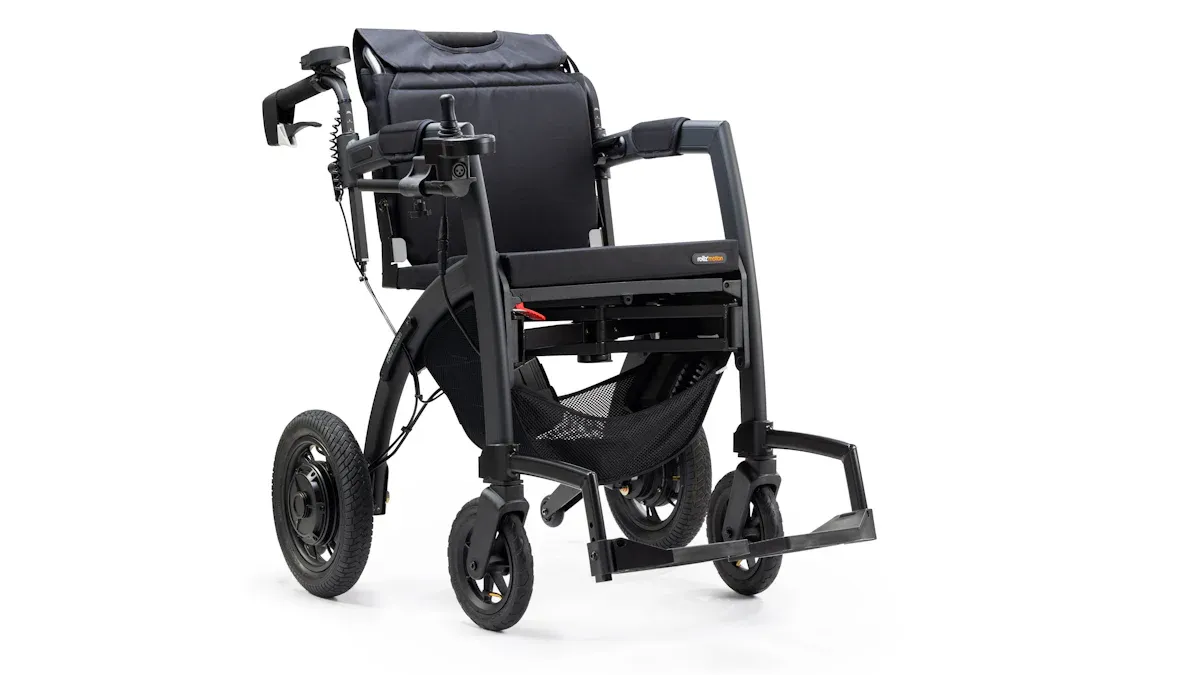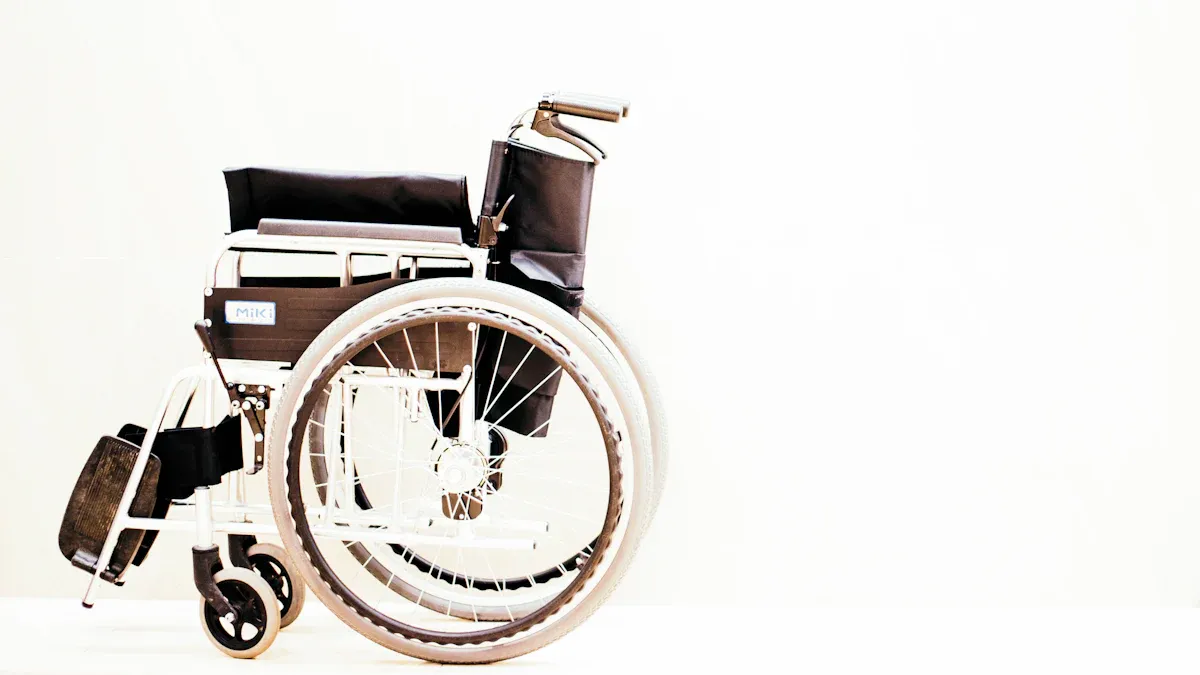
Choosing a lightweight wheelchair can truly change someone’s daily routine. Many people see big improvements in their health and independence after switching. For example:
- Health ratings jump from 4.2 to 6.2 out of 10.
- Independence scores rise from 3.9 to 5.0.
- More people leave home every day, and travel distances increase.
A portable wheel chair or lightweight folding wheelchair feels easier to manage. The table below shows how a light wheelchair reduces physical strain compared to heavier models:
| Measure | Lightweight Wheelchair | Heavier Model | Key Findings |
|---|---|---|---|
| Oxygen Use | Lower | Higher | Less tiring for users |
| Speed | Higher | Lower | Faster movement |
| Distance Travelled | Longer | Shorter | More mobility every day |
Someone who uses a lightweight power wheelchair or lightweight electric wheelchair often finds more comfort and freedom in daily life.
Key Takeaways
- Lightweight wheelchairs reduce physical strain and help users move faster and farther with less effort.
- Materials like aluminum and carbon fiber make wheelchairs easier to push, carry, and store.
- Smart designs and folding features improve portability and make daily routines smoother for users and caregivers.
- Choosing the right wheelchair size, comfort features, and controls boosts independence and daily activity.
- Regular maintenance and proper care keep lightweight wheelchairs working well and extend their lifespan.
What Makes a Lightweight Wheelchair
Lightweight Materials
Manufacturers use special materials to make wheelchairs lighter and easier to handle. Aluminum and carbon fiber are two popular choices. These materials help reduce the overall weight, making it easier for users to move and turn their chairs. Children and caregivers both notice how much simpler it feels to push or carry a chair made from these materials. Some companies even use bio-composite materials, which are lighter and better for the environment.
- Lightweight wheelchairs can go faster and farther than standard models without making users work harder.
- The right components can lower the effort needed to push by up to 41% on tile and 18% on carpet.
- High-strength lightweight wheelchairs, which weigh less than 34 pounds, are perfect for people who need to self-propel for long periods.
Tip: Choosing a wheelchair with lightweight materials can help users stay active and independent every day.
Frame Design and Construction
The frame of a wheelchair matters just as much as the materials. Engineers use advanced tools and testing to create frames that are strong but not heavy. Carbon fiber frames, for example, absorb bumps and vibrations better than older aluminum frames. This means users feel less shaking and enjoy a smoother ride. Some studies show that carbon fiber frames can reduce vibrations in fewer shakes, which helps protect the user’s body from stress.
Modern frame designs also focus on comfort and performance. By using computer models and real-world testing, designers find the best shapes and materials. They want every Lightweight Wheelchair to be easy to use and comfortable for long periods.
Portability and Folding Features
A lightweight wheelchair often comes with smart folding features. These designs let users fold the chair quickly, making it easy to fit into a car trunk or closet. Some models even have quick-release wheels or handles that make carrying and storing the chair simple. Portability helps users and caregivers take the wheelchair anywhere, from a trip to the park to a family vacation.
People who choose a lightweight wheelchair with folding features find it easier to keep up with busy lives. They do not have to worry about heavy lifting or complicated setups. This freedom makes daily routines smoother and more enjoyable.
Benefits of a Lightweight Wheelchair for Daily Life

Easier Transportation and Storage
A lightweight wheelchair makes getting around much simpler. Many people find that these chairs fit easily into cars, buses, or even small storage spaces at home. Rigid frames often help with this because they do not have as many moving parts. This means less energy gets lost when moving the chair. People can fold some models quickly, which saves time and effort.
- Rigid ultra-lightweight wheelchairs often move more smoothly than folding ones.
- Regular maintenance, like keeping tires full and clean, helps the chair roll better.
- Choosing the right tires can make a big difference. Pneumatic tires roll easier than solid ones, so users do not have to push as hard.
Studies show that ultra-lightweight wheelchairs, especially those with rigid frames, help people travel farther and faster. They also last longer if cared for properly. Many users say they feel more confident taking their chair anywhere, whether it is a trip to the store or a family outing.
Tip: Keeping the wheelchair clean and the tires properly inflated helps it stay easy to use every day.
Enhanced Independence and Mobility
A lightweight wheelchair gives people more freedom. Smart designs, like the Phoenix i ultra-lightweight intelligent wheelchair, use technology to help users move safely and easily. Features such as automatic balance, power-assist wheels, and smart brakes help people feel steady and in control. These improvements mean users can go more places on their own.
Research shows that people using ultra-lightweight wheelchairs finish tasks faster and with less effort. For example, in one study, users completed a 100-meter push test about 31 seconds quicker with an ultra-lightweight rigid frame. Their heart rates stayed lower, and they felt less tired. These results mean people can do more on their own, like shopping, visiting friends, or going to school.
- Ultra-lightweight wheelchairs help people learn new skills faster.
- Users report feeling more independent and less worried about getting tired.
- Smart features make it easier to handle hills, bumps, and tight spaces.
A lightweight wheelchair helps people stay active and take part in more activities every day.
Reduced Physical Strain for Users
Using a lightweight wheelchair means less work for the body. These chairs need less energy to push, which protects the arms and shoulders from getting sore. Many models weigh under 34 pounds, making them much easier to move than heavier chairs.
| Numerical Evidence | Description |
|---|---|
| 17% reduction in energy cost | Users spend 17% less energy pushing lightweight wheelchairs. |
| Increased speed and distance | People travel faster and farther with ultra-light chairs. |
| Reduced peak propulsion forces | Lighter chairs lower the force needed to move, especially on tough surfaces. |
People who use lightweight wheelchairs often feel less tired at the end of the day. Custom seating and the right tires also help reduce pressure and make the ride more comfortable. High-quality materials like titanium or aircraft-grade aluminum keep the chair strong but light. This means users can move around more without hurting their bodies.
- Lighter chairs protect the shoulders and arms.
- Good design and materials make pushing easier.
- Custom seating helps prevent pain during long use.
A lightweight wheelchair lets people enjoy daily life with less pain and more comfort.
Less Caregiver Fatigue
Caregivers play a big role in helping people who use wheelchairs. They often help with pushing, lifting, and moving the chair in and out of cars or buildings. When someone uses a heavy wheelchair, these tasks can feel exhausting. Over time, caregivers may feel tired, sore, or even get injured from all the lifting and pushing.
A lightweight wheelchair changes this experience. Caregivers notice right away that it takes less effort to push the chair, especially up ramps or over rough ground. Lifting the chair into a car trunk or carrying it up a few steps becomes much easier. Many caregivers say they feel less back and shoulder pain after switching to a lighter model.
- Lighter chairs reduce the risk of muscle strain and injury.
- Caregivers can help users more often without feeling worn out.
- Quick-folding designs save time and energy during daily routines.
Note: When caregivers feel less tired, they can focus more on spending quality time with their loved ones instead of worrying about physical pain.
Some families even find that a lightweight wheelchair allows one person to handle tasks that used to need two people. This means more freedom for both the user and the caregiver. Everyone can enjoy outings, appointments, and daily activities with less stress.
A lighter chair does not just help the person sitting in it. It also makes life better for the person pushing or lifting it every day.
How to Choose the Right Lightweight Wheelchair

Weight and Size Considerations
Choosing the right wheelchair starts with weight and size. Many people look for a chair that feels light but still strong. Materials like aluminum, carbon fiber, and titanium help keep the chair easy to lift and push. Annual surveys, such as the Sports ‘n Spokes Annual Survey, show that users care about weight, sizing, and how easy it is to move the chair. A chair that fits the user’s body and daily needs makes a big difference. Some people need a chair that folds up small for travel. Others want a chair that can handle rough ground or sports.
Tip: Always check the weight capacity and make sure the chair matches the user’s height and width for the best fit.
Comfort and Adjustability
Comfort matters every day. Studies show that people feel better in chairs with adjustable features. For example, seats and backrests that change angle or height help users stay comfortable longer. One study found that rigid backrests can feel less comfortable than sling backrests, especially for people with certain disabilities. Chairs with more adjustability, like moving the axle or changing the seat angle, help users avoid pain and stay active. Another study showed that ultralight wheelchairs with lots of adjustments scored higher for comfort and ergonomics.
- Adjustable seats and backrests help users find the best position.
- Custom settings can reduce tiredness and make daily tasks easier.
Intended Use and Lifestyle Needs
Everyone uses their wheelchair in different ways. Some people need a chair for school or work. Others want to play sports or travel. Consumer guides suggest matching the chair’s features to the user’s goals and environment. For children, it helps to pick a chair that can grow with them and fit into their social life. Many lightweight wheelchairs now come with foldable frames, reliable brakes, and adjustable footrests. These features make the chair easier to use in many places. Regular maintenance, like cleaning and checking parts, keeps the chair working well for a long time.
- Choose a chair that fits the user’s daily routine.
- Look for features that match the places the chair will go.
Important Features to Look For
When someone shops for a new wheelchair, certain features can make daily life much easier. People often look for options that fit their needs and help them stay comfortable and safe. Here are some of the most important features to consider:
-
Battery Life and Range
For power wheelchairs, battery life matters a lot. A long-lasting battery lets users go out for the day without worrying about running out of power. Some models offer quick-charge batteries or portable options, which help when someone needs to recharge on the go. -
Customization and Comfort
Comfort keeps users happy during long days. Many chairs come with padded seats, adjustable armrests, and footrests. Some even tilt or recline. These features help reduce pressure and keep the body in a healthy position. Ergonomic seating systems, like the Ergo seat, spread weight evenly and lower the risk of pain. -
Control Systems
People have different needs when it comes to controls. Some prefer a joystick, while others need special buttons or switches. Customizable controls help everyone find the best way to move their chair and stay independent. -
Portability and Folding
Lightweight frames with folding designs make travel and storage simple. Swing-away footplates and detachable parts help the chair fit into small spaces. Many users like chairs that fold quickly and easily. -
Safety Features
Safety always comes first. Good wheelchairs have anti-tip wheels, strong brakes, and seatbelts. Some models include reflective strips for better visibility. Crash-tested anchor points add extra protection, especially in cars. -
Price and Warranty
Cost matters, but so does value. Some lightweight models cost more because of special materials or features. A good warranty and easy access to repairs give peace of mind. -
Professional Advice
Trying out different chairs helps people find the right fit. Occupational therapists or mobility experts can offer advice and let users test models before buying.
Tip: Always check the seat size, armrest height, and wheel size. These details affect comfort and how easy the chair is to use every day.
A lighter wheelchair can make daily life smoother and more enjoyable. Studies show that these chairs help people move with less effort and give caregivers a break from heavy lifting. Many users feel more confident and independent when they use a chair that fits their needs. Some research even found that power-assisted models lower heart rates and make daily tasks easier. When choosing a chair, people should think about their lifestyle and comfort. The right choice can open doors to new activities and more freedom.
FAQ
What is the average weight of a lightweight wheelchair?
Most lightweight wheelchairs weigh between 15 and 34 pounds. Some models use carbon fiber or aluminum to keep the weight low. This makes them easy to lift and move.
Can a lightweight wheelchair support heavy users?
Yes, many lightweight wheelchairs support users up to 250 or even 300 pounds. Always check the weight limit before buying. Manufacturers list this information in the product details.
Are lightweight wheelchairs good for outdoor use?
Lightweight wheelchairs work well outdoors. Many models have strong frames and large wheels for rough ground. Some users add special tires for grass or gravel.
How do you clean a lightweight wheelchair?
Use a damp cloth to wipe the frame and seat. Check the wheels for dirt or hair. For deeper cleaning, follow the manufacturer’s instructions. Regular cleaning keeps the chair rolling smoothly.
Do lightweight wheelchairs need special maintenance?
Lightweight wheelchairs need simple care. Users should check tire pressure, tighten bolts, and clean moving parts. A quick check each week helps the chair last longer.
Post time: Jun-13-2025
